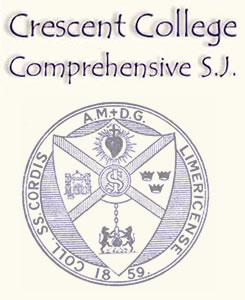
The Society of Jesus, also known as the Jesuit Order or the Jesuits, is a religious order of clerics regular of pontifical right for men in the Catholic Church headquartered in Rome. It was founded in 1540 by Ignatius of Loyola and six companions, with the approval of Pope Paul III. The society is engaged in evangelization and apostolic ministry in 112 nations. Jesuits work in education, research, and cultural pursuits. Jesuits also conduct retreats, minister in hospitals and parishes, sponsor direct social and humanitarian ministries, and promote ecumenical dialogue.

Croom is a village in County Limerick, Ireland. It is located just off the N20 on the River Maigue. It is 8 km southeast of Adare on the N20. The village is in a townland and civil parish of the same name.

Crescent College Comprehensive SJ, formerly known as the College of the Sacred Heart, is a Catholic secondary school located on 40 acres (160,000 m2) of parkland at Dooradoyle, Limerick, Ireland. The college is one of a number of Jesuit schools in Ireland.

Thomas Garnet was a Jesuit priest who was executed in London. He is the protomartyr of Saint Omer and of Stonyhurst College. He was executed at Tyburn and is one of the Forty Martyrs of England and Wales.

Peadar O'Donnell was one of the foremost radicals of 20th-century Ireland. O'Donnell became prominent as an Irish republican, socialist activist, politician and writer.
James Archer (1550–1620) was an Irish Roman Catholic priest of the Society of Jesus who played a highly controversial role in both the Nine Years War and in the military resistance to both the House of Tudor's religious persecution of the Catholic Church in Ireland and the Elizabethan wars against both Gaelic Ireland and the Irish clans. During the final decade of the reign of Queen Elizabeth I, Archer became a leading figure of hate in the anti-Catholic propaganda of the English government, but his most lasting achievement was his role in the establishment and strengthening of the Irish Colleges in Catholic Europe during the Counter-Reformation.
The Second Desmond Rebellion (1579–1583) was the more widespread and bloody of the two Desmond Rebellions in Ireland launched by the FitzGerald Dynasty of Desmond in Munster against English rule. The second rebellion began in July 1579 when James FitzMaurice FitzGerald landed in Ireland with a force of Papal troops, triggering an insurrection across the south of Ireland on the part of the Desmond dynasty, their allies, and others who were dissatisfied for various reasons with English government of the country. The rebellion ended with the 1583 death of Gerald FitzGerald, 14th Earl of Desmond, and the defeat of the rebels.

Irish Catholic Martyrs were 24 Irish men and women who have been beatified or canonized for dying for their Catholic faith between 1537 and 1681 in Ireland. The canonisation of Oliver Plunkett in 1975 brought an awareness of the others who died for the Catholic faith in the 16th and 17th centuries. On 22 September 1992 Pope John Paul II proclaimed a representative group from Ireland as martyrs and beatified them.
Events from the year 1542 in Ireland.
Events from the year 1565 in Ireland.
The Norse-Gaelic Cotter family of Ireland was associated with County Cork and ancient Cork city. The family was also associated with the Isle of Man and the Hebrides.
Events from the year 1575 in Ireland.
Edmund Tanner was an Irish Jesuit, Roman Catholic Bishop of Cork and Cloyne, Ireland, from 1574 to 1579.

Sylvester O'Halloran was an Irish surgeon with an abiding interest in Gaelic poetry and history. For most of his life he lived and practised in Limerick, and was later elected a member of the Royal Irish Academy (RIA).
Sir James Fitz Edmond Cotter was a soldier, a colonial governor and the commander-in-chief of King James's forces, in the Irish Counties of Cork, Limerick, Tipperary and Kerry. He was a prominent political figure in the south of Ireland and was of Royalist and Jacobite sympathies. He was also a member of the Irish Cotter family of Norse-Gaelic origins. He was born around 1630, the second son of Edmond Fitz Garrett Cotter of Anngrove and Elizabeth Connell of Barryscourt, was knighted in 1685–1686, and died in 1705.

Edmund Ignatius Hogan S.J. was an Irish Jesuit scholar.
John Fitzedmund Fitzgerald was the hereditary Seneschal of Imokilly, an Irish nobleman of the originally Anglo-Welsh-Norman FitzGerald dynasty in the province of Munster.

Edmund MacGauran was the Roman Catholic Archbishop of Armagh, Ireland from 1587 to 1593 and Bishop of Ardagh from 1581 to 1587.
David Wolfe was an Irish Jesuit who became papal legate in Ireland.

John Baptist Sleyne was Roman Catholic Bishop of Cork and Cloyne and Apostolic Administrator of the diocese of Ross, who was an enthusiastic patron of the Gaelic language and culture, and an advocate of the severely repressed Roman Catholic population, in Ireland during the early period of the Penal Laws. He was one of only two bishops to minister in Ireland at the end of the 17th century. Sleyne was very learned in languages and moral theology, and had traveled widely. He was known to and had interactions with kings, queens, popes and wider cultural and religious establishment throughout Ireland and Europe. Because Sleyne "remain[ed] in the kingdom contrary to the [penal] law", of the time, he went into hiding. He was eventually brought before the courts in 1698 and spent five years in prison in Cork Gaol. During his time as Bishop, both as fugitive and prisoner, Sleyne ordained many priests and consecrated several bishops in Ireland. He was eventually exiled to Portugal, on 11 February 1703, where he was given shelter in the Irish Dominican Convento do Bom Sucesso, Lisbon. He died in Portugal on 16 February 1712, aged 74 years and is buried at the altar of the Sacred Heart in the Church of Nossa Senhora do Bom Sucesso.









